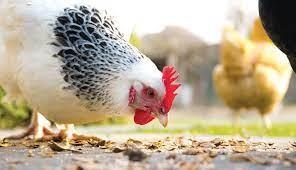Feeding the Right Ration
Nutrition is one of the most important aspects of production. Sixty to seventy percent of the cost of raising poultry is feed. A wide range of high quality commercially prepared feed is available from many sources. Birds must be fed diets that meet their nutritional requirements to achieve maximum production. Nutritional requirements will differ depending on the species of bird. Use the correct type of feed for the birds you are raising. Age also plays a role in selecting the correct feed for your birds.
How much do I feed to provide enough nutrition?
The most convenient way to feed your birds is by purchasing a balanced pelleted or crumble diet. Poultry feeds are referred to as "complete" feeds because they are developed to contain all the nutrients required for growth and health of the bird. Many feed rations prepared commercially today are in pelleted and crumbled form. Medicated feeds are also available to prevent certain diseases. For example, coccidiostats are included in the diet with medicated feeds. If preferred, it is possible to obtain unmedicated feed. Check with feed labels to see what additives have been included in the feed.
Formulating and mixing poultry feed is a complex process that ensures a diet contains all of the nutrients required by the bird. Specialized software programs are usually required to formulate a poultry ration. Therefore, it is recommended feeding a high quality commercial feed which can be purchased from most local farm stores. A list of feed stores in Maryland that sell poultry feed can be found in the Farm Management section of this manual.
Commercial poultry feeds contain numerous similar feed ingredients and several types of rations are available (For example: starter, grower finisher, and layer rations). Different types of rations are formulated to meet the specific requirements of different types of birds. Therefore, to choose the best diet for your flock, you must first know the species of bird, the age of the bird, and for what purpose the birds are being raised (eggs or meat).
A common mistake in feeding poultry is choosing the wrong feed. For example, feeding a broiler ration to layers will result in a calcium deficiency because broiler diets contain a lower level of calcium and would not meet the requirement of a layer. Also it is not recommended to mix grain into a complete commercial ration as this may dilute the nutrient content of the commercial diet, thus resulting in a nutrient deficiency. When birds are not fed a complete ration, it may lead to a decrease in production, feather picking, lameness, and even death.
How often should I feed?
In most cases, birds should have continued access to feed so that they are provided with the proper level of nutrients at all times. Vest and Dale (2002) reported estimates of feed consumption for layers and meat birds at different phases of production in Table 2. Poultry will eat several small meals throughout the day, thus frequenting feeders several times a day. Birds should be allowed free access to feed. When providing feed to your poultry, make sure the feed has protection from the weather. One of the easiest methods to achieve this is to place the feeders inside houses with the chickens. Another method is filling feed troughs so that they are less than half full. Filling feeders with only enough feed for the birds to consume in one day will also minimize waste. This reduces the amount of feed loss, as well as allowing the caretaker to control rations for the birds.
If placing the feeders inside housing is not feasible, there are feeders on the market that have lids and rain shields to prevent the feed from becoming wet, allowing feeders to remain outside. Contact your local feed or farm store to find out what feeders and poultry supplies they carry. The type of feeder used for your operation is dependent on individual management practices. Be sure to keep feed troughs clean and dry as well as supplied with fresh, dry feed regardless of location.
How should feed be stored?
After purchasing the correct feed for your birds, keeping it fresh is very important. Feeding old, moldy feed can cause your birds to become very sick. There are several options to storing feed. Large metal or plastic bins are popular for storing large quantities of feed. Make sure any container being used has a lid that will keep the feed from getting wet and prevents rodents access. Metal containers are recommended over plastic containers because rodents cannot chew through metal containers as they can with plastic containers. When rodents gain entry into containers, the feed becomes contaminated. DO NOT feed contaminated feed to birds. Birds may become sick or contract a disease from contaminated feed (see Avian Diseases of Concern). Any type of storage container can be used as long as it is sealed so your birds and unwanted pests (including other farm animals) cannot gain access to feed.
Conclusion
Remember feed is an investment. Approximately 70% of the cost of raising poultry is feed. Feeding a high quality feed to your flock will promote bird health and performance. Although purchasing low quality feed will save you a few dollars in the beginning, it may cost you a lot more in bird health and performance. Productivity, reproduction, and health of the flock largely depends on the quality of feed they will receive. Additionally, feeding the right feed for the type and age of the bird you are raising is simple and vital to a productive flock. Keep in mind the better the birds are fed, the more productive they will be!
References:
Vest, L. and N. Dale. 2002. Nutrition for the backyard flock. The University of Georgia Cooperative Extension Service. Leaflet 396.
Files:
